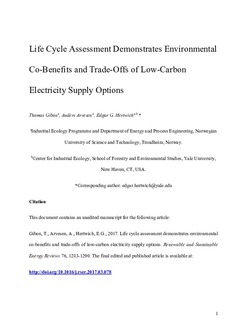| dc.contributor.author | Gibon, Thomas | |
| dc.contributor.author | Arvesen, Anders | |
| dc.contributor.author | Hertwich, Edgar G. | |
| dc.date.accessioned | 2017-11-20T16:17:35Z | |
| dc.date.available | 2017-11-20T16:17:35Z | |
| dc.date.created | 2017-04-09T14:44:45Z | |
| dc.date.issued | 2017 | |
| dc.identifier.citation | Renewable & Sustainable Energy Reviews. 2017, 76 1283-1290. | nb_NO |
| dc.identifier.issn | 1364-0321 | |
| dc.identifier.uri | http://hdl.handle.net/11250/2467220 | |
| dc.description.abstract | The targeted transition towards an electricity system with low or even negative greenhouse gas emissions affords a chance to address other environmental concerns as well, but may potentially have to adjust to the limited availability of assorted non-fossil resources. Life cycle assessment (LCA) is widely recognized as a method appropriate to assess and compare product systems taking into account a wide range of environmental impacts. Yet, LCA could not inform the latest assessment of co-benefits and trade-offs of climate change mitigation by the Intergovernmental Panel on Climate Change due to the lack of comparative assessments of different electricity generation technologies addressing a wide range of environmental impacts and using a consistent set of methods. This paper contributes to filling this gap. A consistent set of life cycle inventories of a wide range of electricity generation technologies is assessed using the Recipe midpoint methods. The life-cycle inventory modeling addresses the production and deployment of the technologies in nine different regions. The analysis shows that even though low-carbon power requires a larger amount of metals than conventional fossil power, renewable and nuclear power leads to a reduction of a wide range of environmental impacts, while CO2 capture and storage leads to increased non-GHG impacts. Biomass has relatively modest co-benefits, if at all. The manufacturing of low-carbon technologies is important compared to their operation, indicating that it is important to choose the most desirable technologies from the outset. | nb_NO |
| dc.language.iso | eng | nb_NO |
| dc.publisher | Elsevier | nb_NO |
| dc.relation.uri | http://doi.org/10.1016/j.rser.2017.03.078. | |
| dc.rights | Attribution-NonCommercial-NoDerivatives 4.0 Internasjonal | * |
| dc.rights.uri | http://creativecommons.org/licenses/by-nc-nd/4.0/deed.no | * |
| dc.title | Life cycle assessment demonstrates environmental co-benefits and trade-offs of low-carbon electricity supply options | nb_NO |
| dc.type | Journal article | nb_NO |
| dc.type | Peer reviewed | nb_NO |
| dc.description.version | acceptedVersion | nb_NO |
| dc.source.pagenumber | 1283-1290 | nb_NO |
| dc.source.volume | 76 | nb_NO |
| dc.source.journal | Renewable & Sustainable Energy Reviews | nb_NO |
| dc.identifier.doi | 10.1016/j.rser.2017.03.078 | |
| dc.identifier.cristin | 1464575 | |
| dc.relation.project | Norges forskningsråd: 209697 | nb_NO |
| dc.description.localcode | © 2017. This is the authors’ accepted and refereed manuscript to the article. LOCKED until 3.4.2019 due to copyright restrictions. This manuscript version is made available under the CC-BY-NC-ND 4.0 license http://creativecommons.org/licenses/by-nc-nd/4.0/ | nb_NO |
| cristin.unitcode | 194,64,25,0 | |
| cristin.unitname | Institutt for energi- og prosessteknikk | |
| cristin.ispublished | true | |
| cristin.fulltext | postprint | |
| cristin.qualitycode | 1 | |

